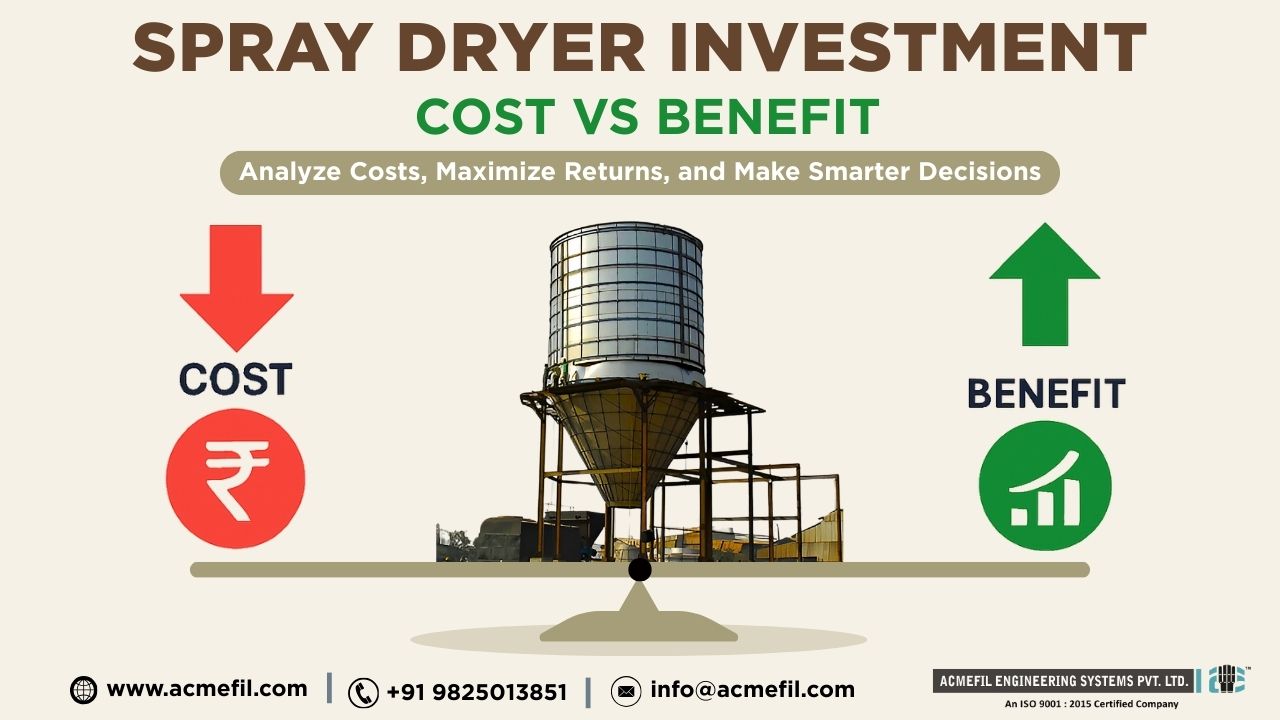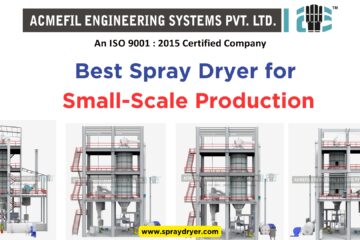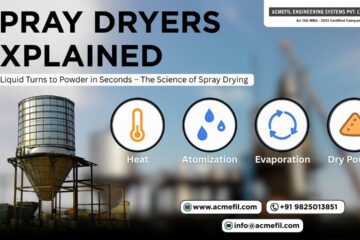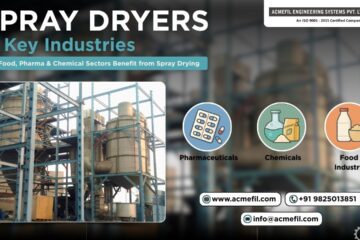Did you know that companies implementing spray drying technology can reduce their production costs by up to 30% over traditional drying methods? The global spray dryer market is projected to reach $7.5 billion by 2027, growing at a CAGR of 6.9%. If you’re considering making this significant investment for your manufacturing operation, you’re facing a complex decision that could dramatically impact your production efficiency, product quality, and bottom line for years to come.
This comprehensive guide will walk you through a detailed cost-benefit analysis of investing in a spray dryer, helping you determine if this technology is the right solution for your business needs. We’ll examine initial investment costs, operational benefits, financial returns, and essential considerations that will empower you to make an informed decision about this critical capital expenditure.
What Is a Spray Dryer and How Does It Work?
A spray dryer is a specialized piece of equipment that converts liquid materials into dry powder form through a rapid drying process. The technology works by atomizing a solution or slurry into fine droplets and exposing them to hot air in a drying chamber. This process causes the moisture to evaporate almost instantly, leaving behind dry particles that are then collected.
The basic operational steps include:
- Feeding the liquid material into the dryer
- Atomizing the liquid into fine droplets
- Mixing the droplets with hot air
- Evaporating the moisture
- Separating the dry powder from the air
- Collecting the final product
This efficient drying method is particularly valuable for heat-sensitive materials, as the rapid evaporation process keeps the product at a relatively low temperature despite the hot drying air.
The True Cost of Investing in a Spray Dryer
When conducting a cost-benefit analysis of investing in a spray dryer, it’s essential to consider all associated expenses. The true cost extends far beyond the initial purchase price of the equipment.
Initial Capital Expenditure
The upfront cost of a spray dryer typically ranges from $50,000 for small laboratory models to over $2 million for large industrial systems. This wide price range depends on several factors:
- Production capacity requirements
- Material construction quality (stainless steel grade)
- Control system sophistication
- Energy recovery features
- Atomization technology
- Auxiliary equipment needs
Installation and Facility Modifications
Installing a spray dryer often requires facility modifications that can add 15-30% to the initial equipment cost:
- Structural reinforcements to support equipment weight
- Ventilation system upgrades
- Utility connections (steam, compressed air, electricity)
- Product handling and packaging line integration
- Dust collection systems
- Safety compliance modifications
Operational Costs
The ongoing operational expenses include:
- Energy consumption (typically 1.2-1.7 kWh per kg of water evaporated)
- Labor requirements for operation and maintenance
- Consumable parts replacement
- Cleaning and sanitization procedures
- Quality control testing
- Preventive maintenance
Training and Staffing
Implementing a spray dryer requires specialized knowledge:
- Operator training programs ($5,000-$15,000)
- Potential hiring of specialized personnel
- Ongoing technical education
- Process optimization expertise development
Regulatory Compliance
Depending on your industry, additional costs may include:
- Food safety certifications
- Pharmaceutical validation requirements
- Environmental permits
- Emissions control equipment
- Documentation systems
The Significant Benefits of Spray Dryer Implementation
Product Quality Improvements
Spray drying delivers remarkable consistency and quality advantages:
- Precise particle size control (typically 10-500 μm)
- Enhanced product stability and shelf life (up to 2-3 years for many products)
- Uniform composition throughout batches
- Improved solubility characteristics
- Elimination of contamination risks associated with slower drying methods
- Customizable particle properties (density, flowability)
Operational Efficiency Gains
The efficiency improvements can be substantial:
- Production capacity increases of 200-300% compared to other drying methods
- Reduced labor costs through automation
- Continuous production capability versus batch processing
- Lower energy consumption per unit of production
- Smaller facility footprint requirements
- Reduced inventory holding costs through just-in-time production
Market and Product Development Opportunities
Spray drying opens new business possibilities:
- Access to higher-value product categories
- Development of new formulations previously unachievable
- Ability to meet stricter customer specifications
- Premium pricing potential for enhanced quality products
- Contract manufacturing opportunities
- Intellectual property development
Cost Reduction Potential
Direct savings often include:
- Reduced waste (typically 2-5% versus 7-15% with other methods)
- Lower transportation costs for dry versus liquid products
- Decreased storage space requirements
- Extended shelf life reducing returns and disposals
- Elimination of cold chain requirements for certain products
ROI Analysis: When Will Your Investment Pay Off?
Calculating Payback Period
The typical payback period for a spray dryer investment ranges from 18-36 months, depending on:
- Production volume and utilization rate
- Product value differential (pre vs. post-implementation)
- Energy cost savings
- Labor efficiency gains
- Waste reduction value
Net Present Value Considerations
When calculating the NPV of your spray dryer investment, consider:
- Expected equipment lifespan (typically 15-20 years)
- Annual maintenance cost increases (averaging 2-3% per year)
- Energy price trend projections
- Production volume growth forecasts
- Potential for product price premiums
Depreciation and Tax Implications
Consult with your financial advisor about:
- Accelerated depreciation options
- Energy efficiency tax incentives
- R&D tax credits for process improvements
- Investment tax credits available in your region
- Carbon reduction incentive programs
Spray Dryer Selection: Matching Technology to Your Needs
Production Capacity Requirements
Selecting the right size system is critical:
- Pilot-scale: 1-5 kg/hr water evaporation
- Small production: 5-50 kg/hr water evaporation
- Medium production: 50-250 kg/hr water evaporation
- Large industrial: 250-4,000+ kg/hr water evaporation
Accurately assessing your needs helps avoid costly overcapacity or frustrating undercapacity situations.
Feed Properties Considerations
Your specific material characteristics determine equipment design requirements:
- Viscosity limitations (typically up to 300 cP)
- Solids content ranges (1-50%)
- Heat sensitivity thresholds
- Particle size objectives
- Sterility requirements
- Corrosiveness concerns
Energy Efficiency Options
Modern spray dryers offer various energy-saving technologies:
- Heat recovery systems (reducing energy consumption by 15-30%)
- Multi-stage drying configurations
- Optimized atomization systems
- Variable speed drives
- Intelligent control systems
- Insulation improvements
Automation and Control Systems
Advanced control options impact both cost and performance:
- Basic manual controls versus fully automated operation
- Recipe management systems
- Process analytical technology integration
- Remote monitoring capabilities
- Predictive maintenance features
- Data logging and compliance reporting
Implementation Challenges and Solutions
Timeline Considerations
A typical spray dryer implementation follows this timeline:
- Engineering and design: 2-3 months
- Equipment fabrication: 3-8 months
- Installation: 1-2 months
- Commissioning and validation: 1-3 months
- Production ramp-up: 1-2 months
Plan for potential production disruptions during installation and commissioning.
Common Implementation Pitfalls
Be aware of these frequent challenges:
- Underestimating utility requirements
- Insufficient operator training
- Inadequate product testing prior to full implementation
- Poor integration with existing production lines
- Improper facility preparation
- Unrealistic production ramp-up expectations
Success Factors
Companies that achieve the best ROI typically focus on:
- Thorough pre-purchase product testing
- Comprehensive operator training programs
- Gradual production scale-up
- Regular preventive maintenance
- Continuous process optimization
- Leveraging supplier expertise
Industry-Specific Considerations
Food and Dairy Applications
The food industry has specific considerations:
- Hygienic design requirements (3A, EHEDG compliance)
- Clean-in-place (CIP) system compatibility
- Allergen management capabilities
- Flavor retention technologies
- Nutrient preservation features
- Product reconstitution performance
Pharmaceutical and Biotech Requirements
For pharmaceutical applications, focus on:
- cGMP compliance features
- Validation documentation packages
- Containment capabilities for potent compounds
- Cross-contamination prevention
- Process analytical technology integration
- Sterile processing options
Chemical and Industrial Applications
Industrial applications demand attention to:
- Explosion protection designs
- Corrosion-resistant materials
- Abrasion handling capabilities
- Emissions control technologies
- High-temperature operation options
- Recovery of valuable solvents
Case Studies: Real-World ROI from Spray Dryer Investments
Medium-Sized Dairy Processor
A dairy ingredients manufacturer invested $1.2 million in a new spray drying system and achieved:
- 35% increase in production capacity
- 28% reduction in energy consumption per kg of product
- 18-month payback period
- New high-value product development capabilities
- Significant improvement in product consistency
Pharmaceutical Contract Manufacturer
A contract manufacturing organization reported these results from their $1.8 million investment:
- Ability to take on 4 new high-value contracts
- 22% improvement in batch-to-batch consistency
- Reduction in QC rejection rate from 3.8% to 0.5%
- 24-month return on investment
- Expanded customer base in specialty formulations
Specialty Chemical Producer
A specialty chemical company investing $950,000 in spray drying technology achieved:
- Development of 3 new patent-pending products
- Entry into premium market segments
- 40% reduction in production footprint
- Enhanced workplace safety metrics
- 20-month payback period
Frequently Asked Questions About Spray Dryer Investments
How does spray drying compare to freeze drying in terms of cost?
While freeze drying often produces superior quality for certain applications, spray drying typically requires 40-60% less capital investment and operates with 25-35% lower energy costs. Spray drying also offers significantly higher production throughput, often 5-10 times that of equivalently priced freeze drying equipment.
What are the typical maintenance requirements for spray dryers?
Expect to allocate approximately 3-5% of the initial capital cost annually for maintenance. Critical components requiring regular attention include atomization devices (every 500-1000 hours), air filtering systems (monthly), gaskets and seals (quarterly), and control system calibration (semi-annually).
How difficult is it to switch between different products on a spray dryer?
Product changeover complexity varies based on formulation similarities, contamination concerns, and regulatory requirements. Simple changeovers between similar products may require only 2-4 hours, while complex situations involving allergens or potent compounds can require 1-2 days of cleaning and validation.
What are the most significant factors affecting spray dryer ROI?
The three most impactful factors are typically: utilization rate (aim for 80%+ of capacity), product value-add potential (higher for specialty products), and energy efficiency. Secondary factors include labor savings, waste reduction, and new market access.
Can spray dryers handle heat-sensitive materials?
Yes, despite using hot air, the evaporative cooling effect and extremely short residence time (typically 5-30 seconds) protect sensitive materials. Inlet temperatures of 120-180°C often result in product temperatures of only 50-80°C, making the process suitable for many enzymes, probiotics, and pharmaceutical compounds.
Making Your Decision: Key Evaluation Steps
Define Your Objectives Clearly
Before investing, clearly articulate:
- Primary process goals (quality, capacity, new capabilities)
- Production volume targets
- Product specification requirements
- Budget constraints
- Implementation timeline needs
- Future expansion considerations
Conduct Thorough Testing
Minimize risk through:
- Pilot-scale trials with your actual materials
- Multiple product formulation testing
- Extremes of operating conditions evaluation
- Sample analysis by potential customers
- Third-party verification of results
Select the Right Supplier
Evaluate potential vendors on:
- Industry-specific experience
- References from similar applications
- Local service and support capabilities
- Training program quality
- Spare parts availability
- Process development assistance
Secure Internal Buy-In
Ensure organizational support by:
- Involving operations team in selection process
- Educating management on ROI expectations
- Developing clear implementation milestones
- Creating contingency plans for challenges
- Establishing key performance indicators
Conclusion: Balancing Cost and Benefit
Investing in a spray dryer represents a significant financial commitment but offers substantial potential returns through improved product quality, operational efficiency, and market opportunities. By conducting a thorough cost-benefit analysis specific to your operation, you can make a confident, data-driven decision about this important technology investment.
The key to maximizing ROI is selecting appropriately sized equipment with the right features for your specific application, investing in proper training, and establishing continuous optimization processes. While the initial capital outlay may seem daunting, the long-term operational benefits frequently deliver payback periods of less than three years for well-planned implementations.
As with any major capital investment, success depends not just on the technology itself but on how effectively it is integrated into your overall production strategy. By taking a systematic approach to evaluation and implementation, you can transform spray drying technology from a significant expense into a powerful competitive advantage.
About Acmefil Engineering Systems
Looking for a reliable spray drying solution provider? Acmefil Engineering Systems Pvt. Ltd., an ISO 9001:2015 certified Indian company established in 1992, designs and manufactures advanced industrial drying equipment including state-of-the-art spray dryers. Our spray drying systems feature precision atomization technology, energy-efficient designs, and intelligent control systems that maximize product quality while minimizing operational costs. With applications across food, pharmaceutical, and chemical industries, Acmefil delivers customized turnkey solutions backed by three decades of expertise and over 800 successful installations nationwide. Experience the perfect balance of innovative engineering, reliability, and cost-effectiveness with Acmefil spray drying technology.




